|
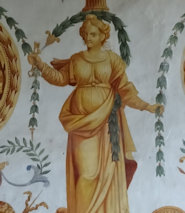 Dwight Peck's personal website Dwight Peck's personal website
Sirmione and the neighborhood, May 2016
Ten days in the home of the Scaligeri and the heretics
You may not find this terribly rewarding unless you're included here, so this is a good time for casual and random browsers to turn back before they get too caught up in the sweep and majesty of the proceedings and can't let go.
Settimo Vittone and the Castello di Masino
The first day: On the Road, 9-10 May 2016
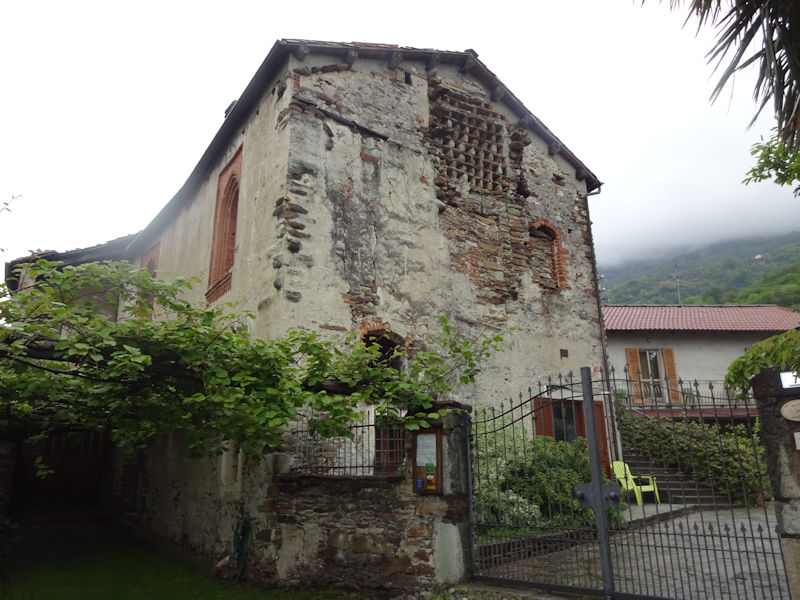
Two hours over the Grand St-Bernard Pass (through the tunnel), we're at the Ospitalità del Castello, our favorite B+B in the region. Settimo Vittone is just south of the border between the regions of the Valle d'Aosta and the Piedmont, a good low-stress day's drive southward.
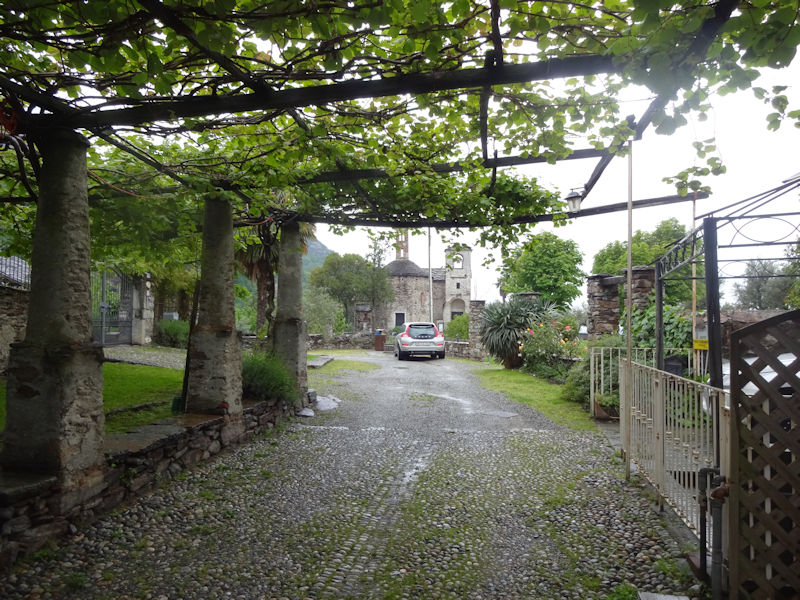
Historical charm with modern amenities, extremely low rates, wonderful hosts, whom we're now awaiting in a drizzly rain because we've arrived a few minutes before them. We were last here in mid-February, and the weather then was much better than it is today.

In the front yard, we've got the Pieve di San Lorenzo and baptistery of San Giovanni Battista, 9th and 10th century structures miraculously surviving, must-see medieval waystops along the Via Francigena pilgrimage route.
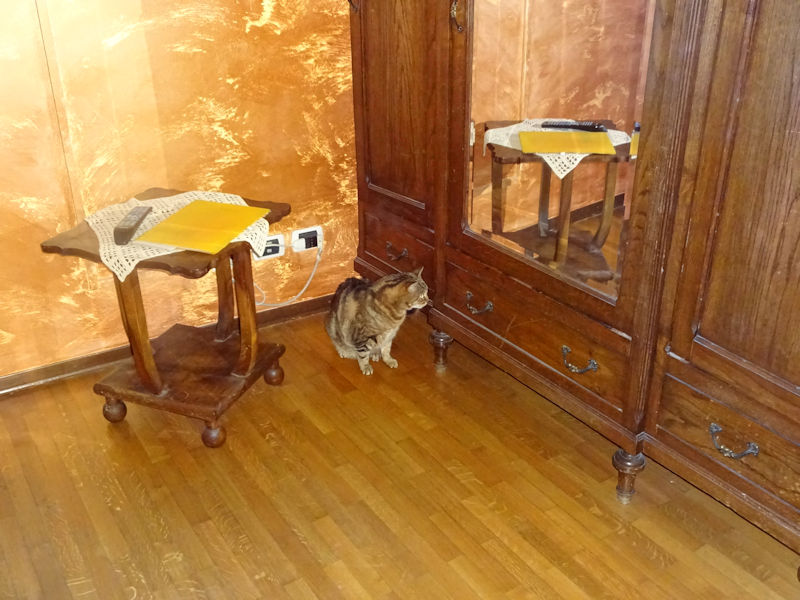
The Squirrel's instincts in an unfamiliar environment kick in: find an armoire to hide in.
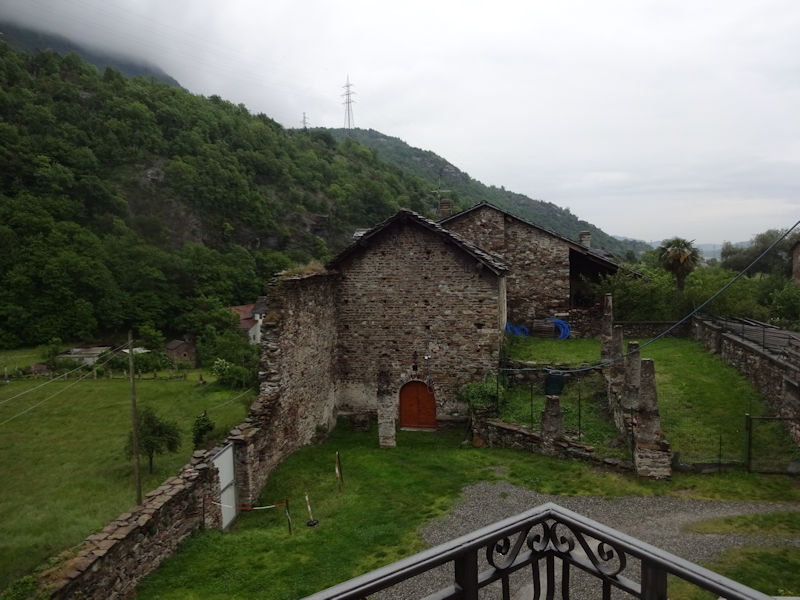
From one of our two balconies (still raining)
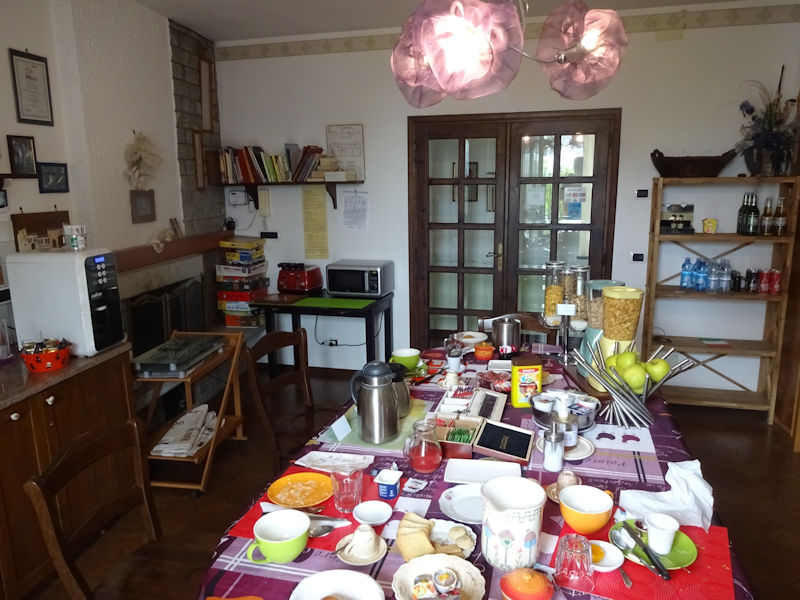
After a good breakfast the next day, we're off.
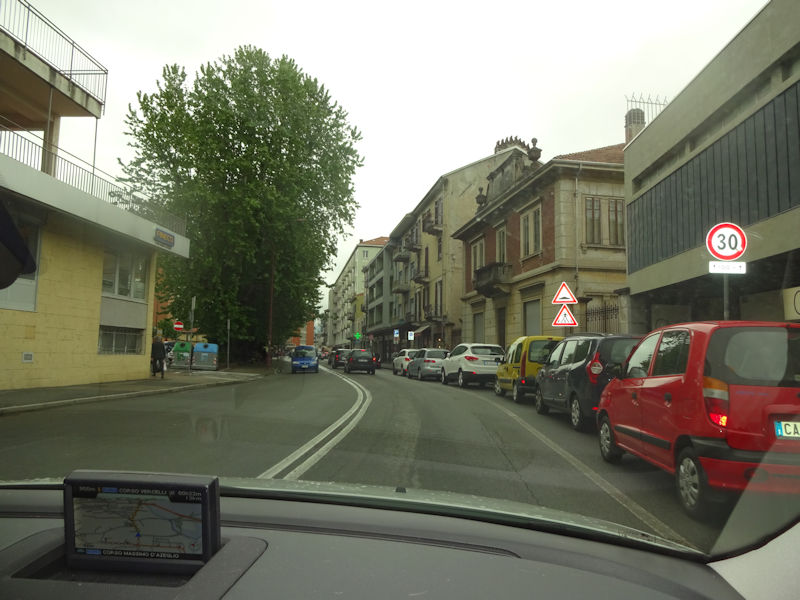
We're looking for a particular castle for a hasty visit, and the Volvo satnav is winding us through small towns around the peripheries of Ivrea, near the Albiano d'Ivrea exit from the autostrada.

There's the castle. Not actually -- it's the wrong one. But it turned out to be interesting anyway.
The Castello e Parco di Masino

As it turns out, we're at the Castello di Masino, with its park and little dependent village, or 'borgo'.
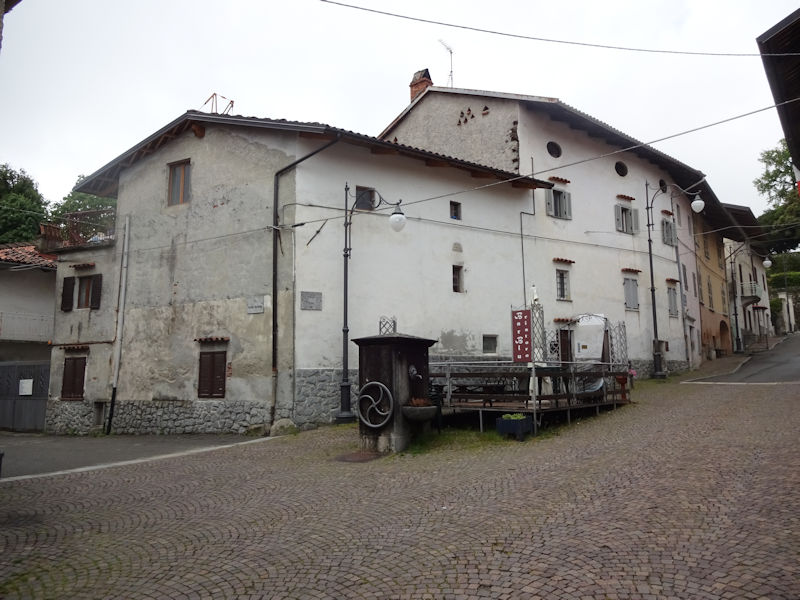
Something castley and medievalish has been here forever, owned by the Valperga family, Counts of Masino, who claimed to have been in residence here since the days of Arduin, Margrave of Ivrea, who was arguably the King of Italy from 1002 to 1014. (It's not clear who elected him king, but the new Holy Roman Emperor Henry II was not agreeable, and came over the Alps and destroyed Pavia for having supported him. Arduin's terrified friends deserted him, and he went into a major murderous snit and tried to punish everybody, largely wrecking Vercelli, Novara, Como, all over the region. Then he joined a monastery.)
The castle on this site seems to date from the 11th century, but was rebuilt after the Savoyards destroyed it in the mid-16th century. The present borgo extending down from the castle, however, dates from major redesigns of the park and grounds in the 1820s.

Up to the castle, past a tower that apparently dates from the 17th century. The last of the Valpergas (the Marchioness) passed away in 1987, and the property was inherited by the FAI, the Fondo Ambiente Italiano (what the English would call the "National Trust"), in 1987.
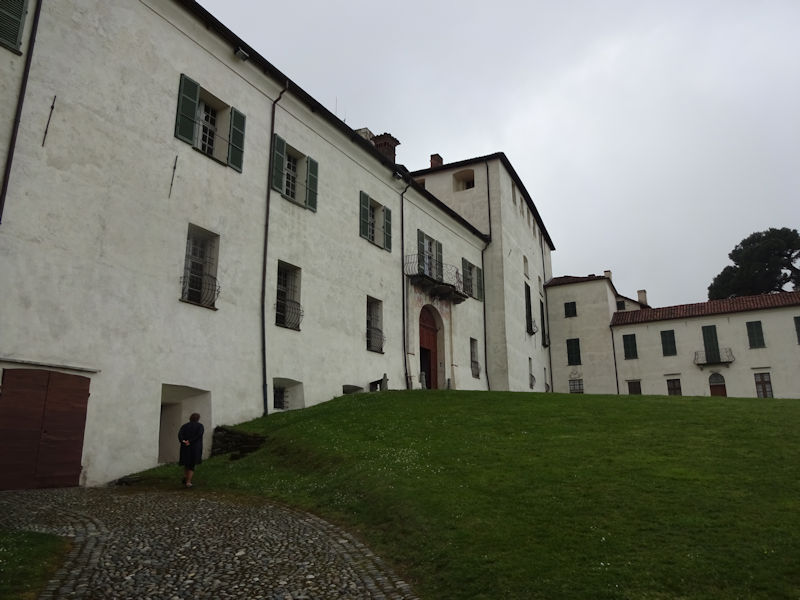
The main body of the present buildings forms a giant "L", but the original castle was a square with corner towers. The larger building at the far end is the 17th century keep.
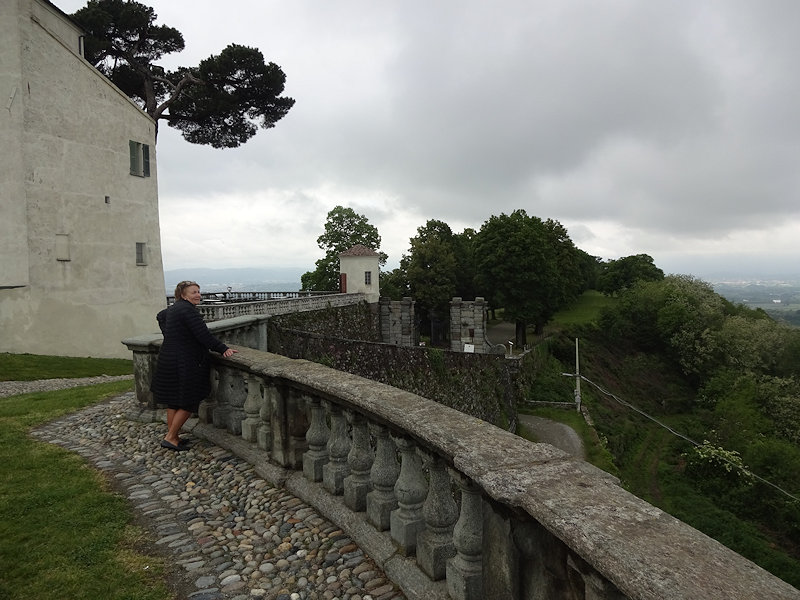
The castle was placed strategically, overlooking all of the Canavese historical region, from Ivrea and up the Aosta valley to the north, Vercelli to the east, and the flat lands in the direction of Turin to the south.

We begin, through the 18th century main doors.
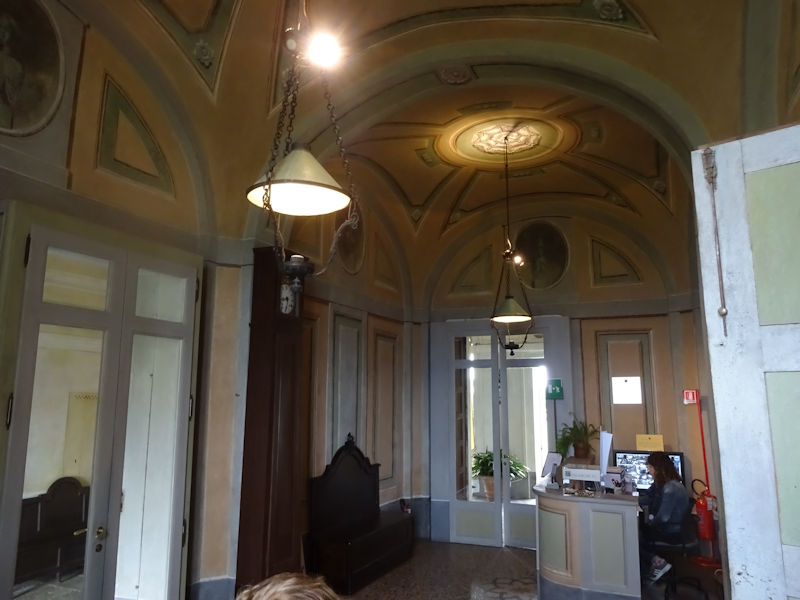
Dawdling, awaiting our volunteer guide who's on a well-deserved coffee break.
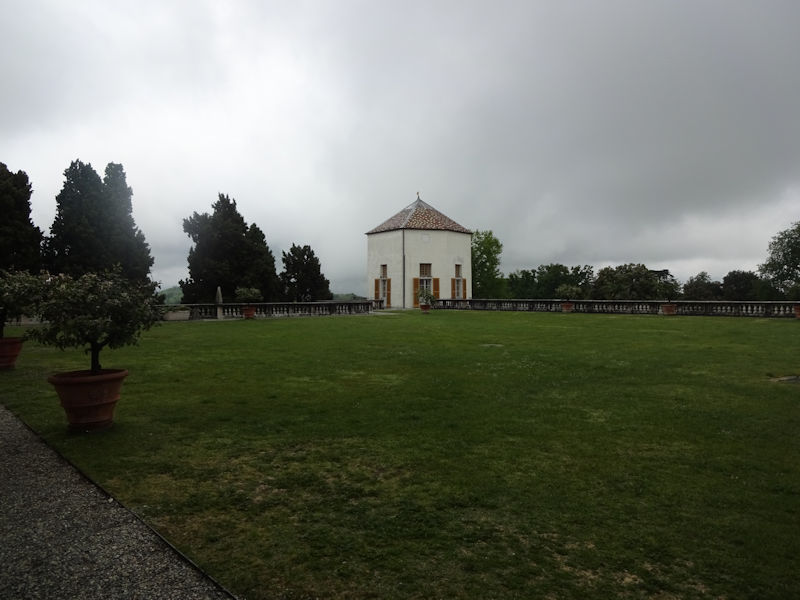
On the far side of the main block, we're basically on what might once have been a courtyard, missing two sides of it now. The story is fascinating: in the 16th century, during the time of the "military revolution" when the advent of massed and effective artillery made high stone castles obsolete, much of the original Masino castle, which had been destroyed by the Savoyards, was reconstructed in the ensuing years in a more modern style. The high walls and towers are gone now, but the guts of the old castle are still here -- underneath all this. Some of it, dark and labyrinthine, is visitable on special occasions, and our guide sometimes takes school groups down through the dark corridors below. And brings them back, of course.
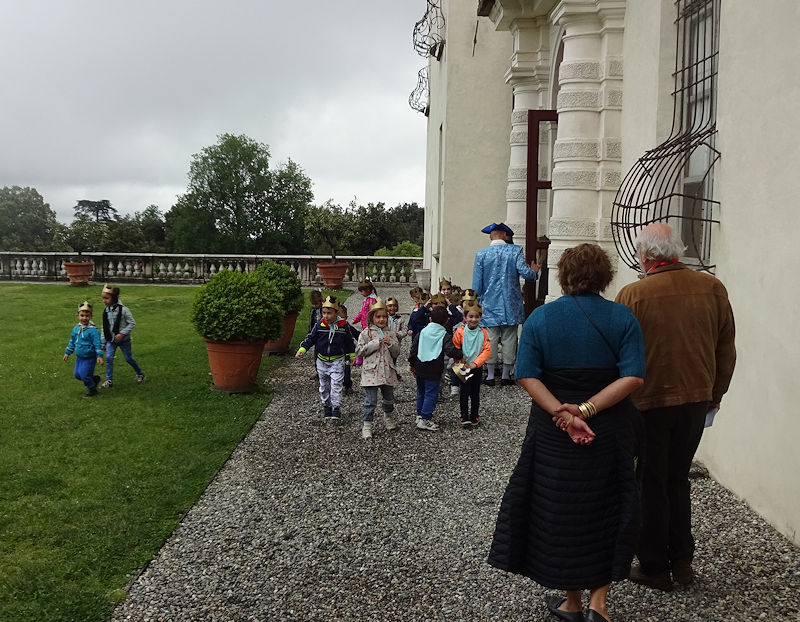
That is our knowledgeable guide with Kristin, and a school group with their paper crowns on -- and a guide of their own more fancifully dressed than ours.
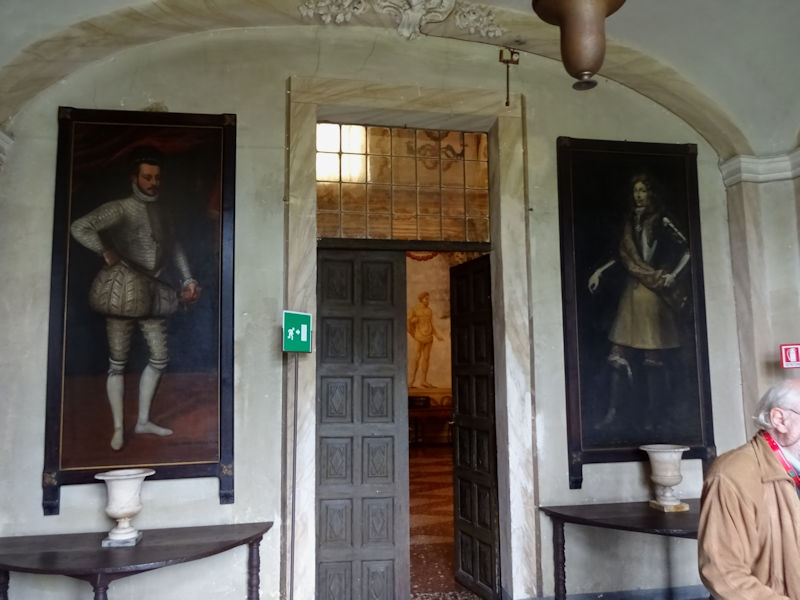
The interior entrance hall, in effect, off the courtyard
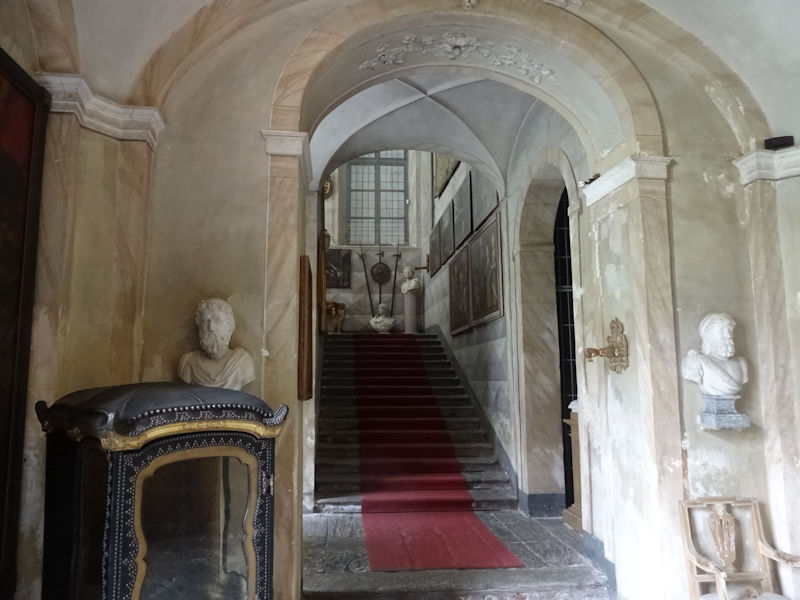
And a grand staircase, to which we shall return
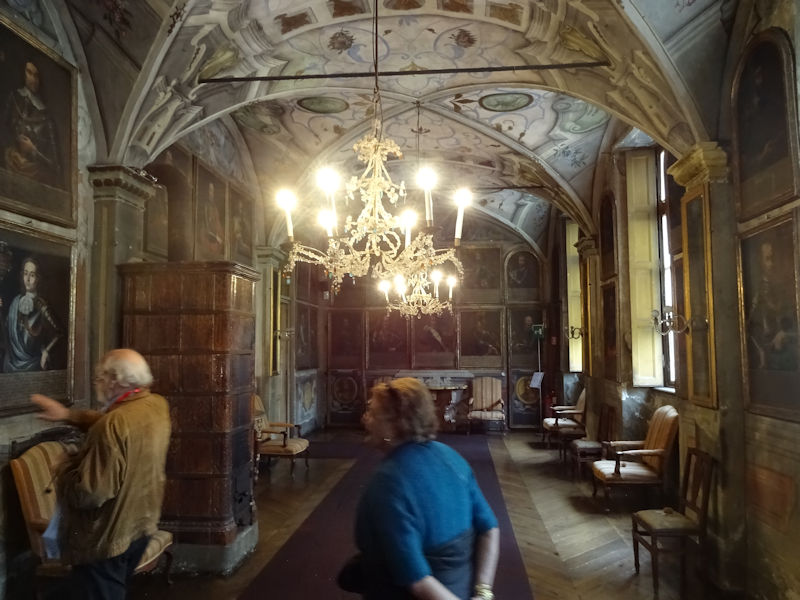
This is the "ancestors' gallery", developed in the 1740s to display portraits of all the most illustrious Valpergas going back to the beginning, bringing the line up to the early 19th century. Naturally, nearly all of the early likenesses are fanciful.
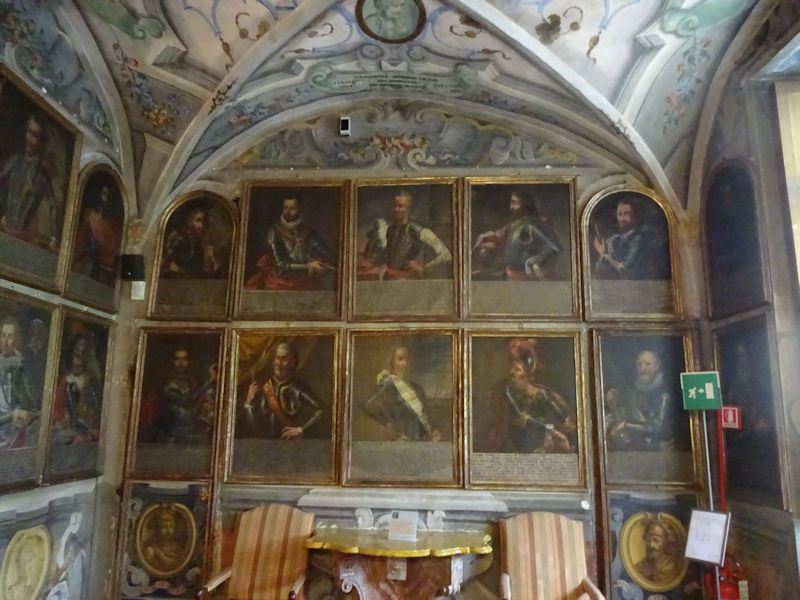
It must have been a stirring experience for young family members, gazing back over their famous forebears, even though it's basically all bollocks.
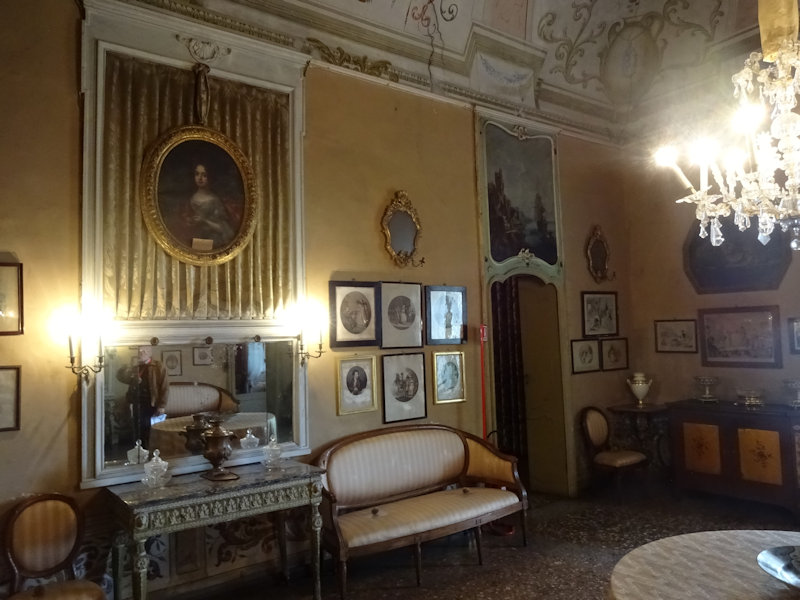
The Summer Dining Room
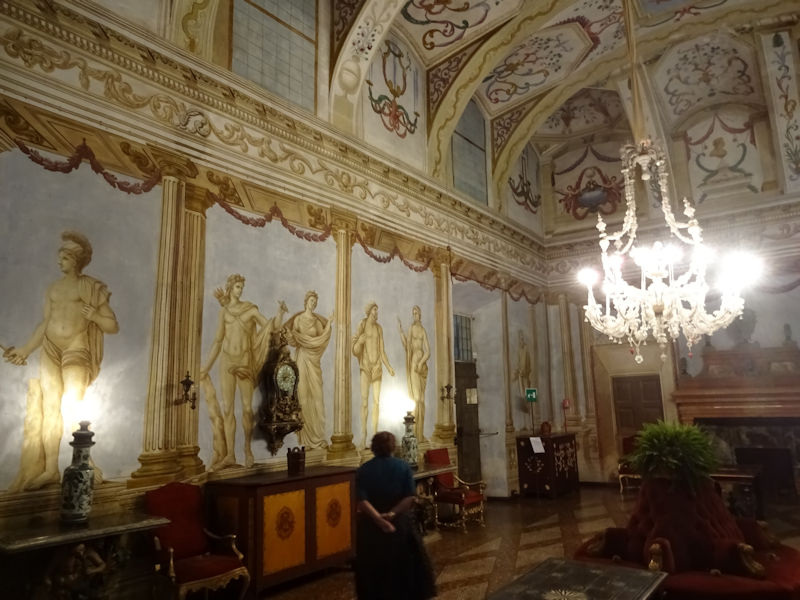
The Salon of the Gods, with neoclassical themes
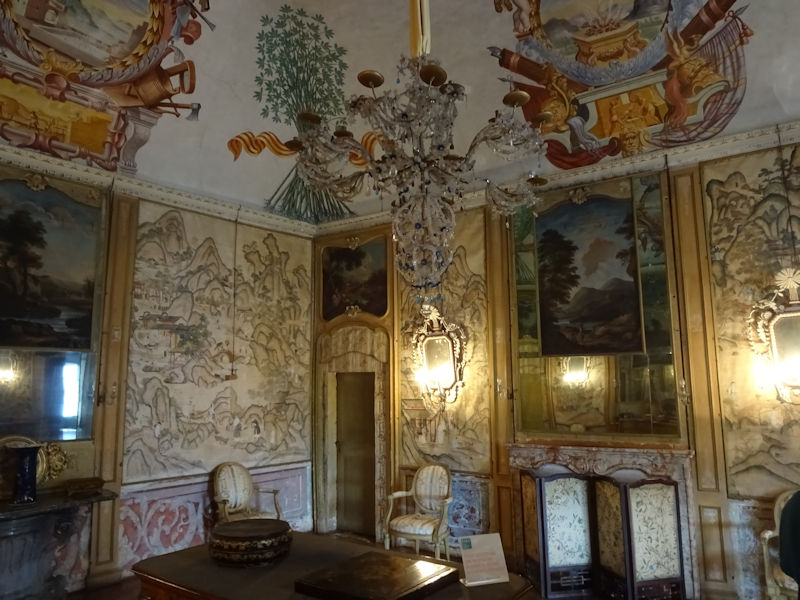
Still on the ground floor, this is part of the Queen's Apartment
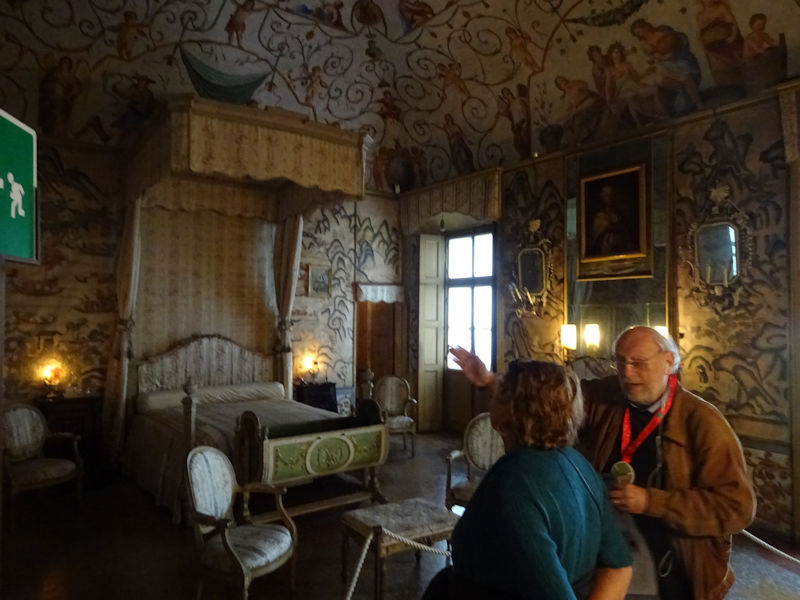
The bedroom in the Queen's Apartment, with ca. 18th century furnishings
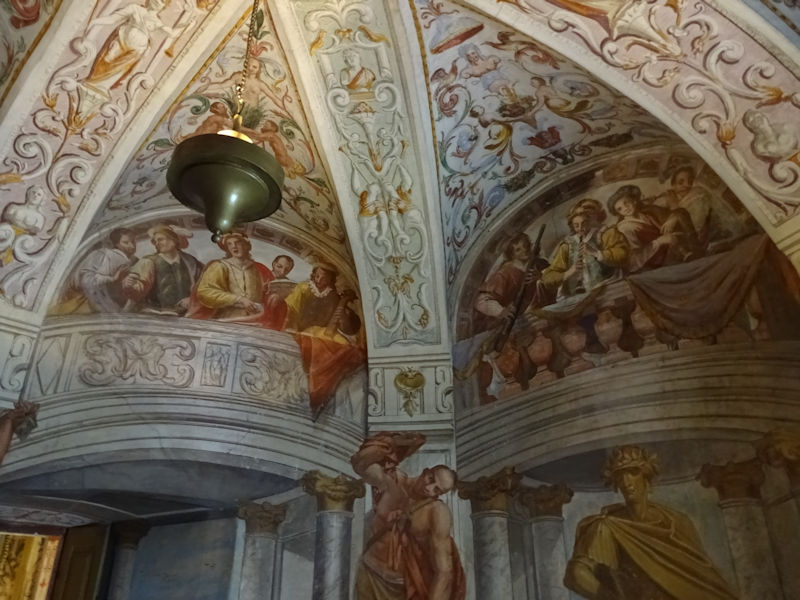
The round music room in the Queen's Apartment, decorated in the late 17th and early 18th centuries with musicians aloft and . . .

. . . American Indians holding them all up.
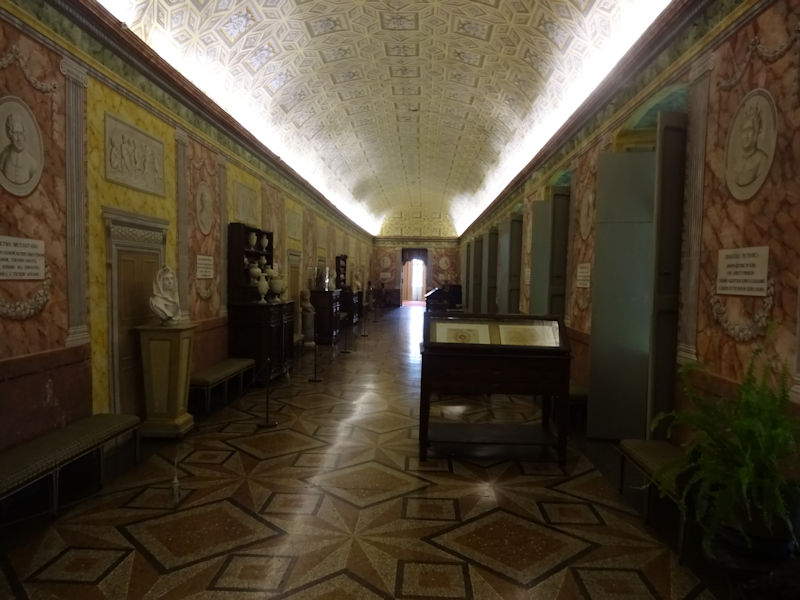
At the top of the Grand Staircase, the Poets' Gallery, a 17th century hall transformed in the early 19th century with portraits of Italian literary and cultural luminaries, beginning with Dante, Petrarch, and Boccaccio up to Alfieri, the tragedian from Asti.

The Savoia Room, an upstairs room in the 17th century corner keep, with a set of "beautiful ladies" portraits in oval frames done by and in the manner of the popular late-17th century Flemish artist J. F. Voet, portraitist to the stars.
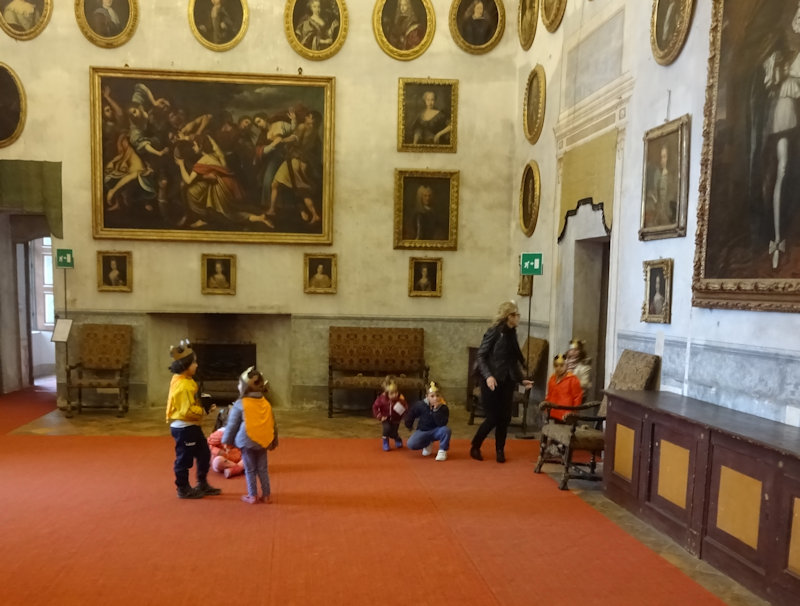
A bathroom break
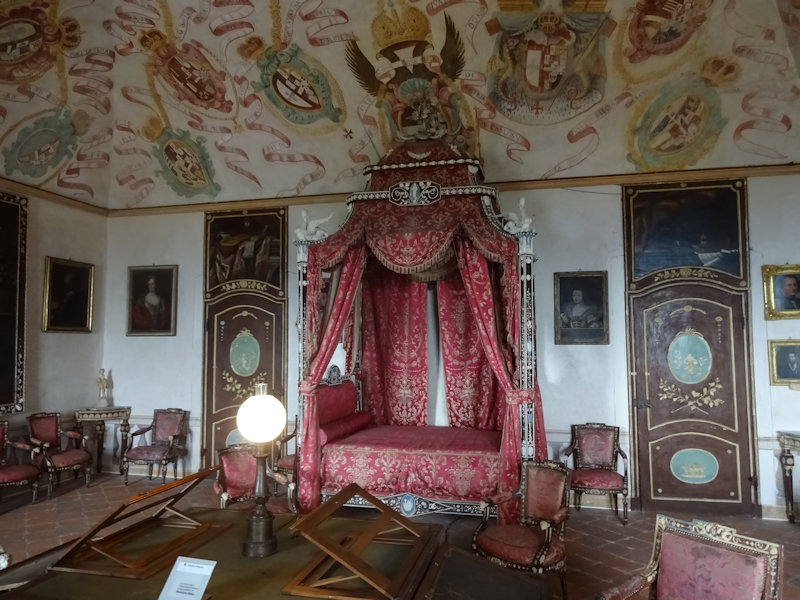
The Ambassadors' Chambers next door, with coats of arms of great European dynasties with whom the Valperga Counts of Masino were connected, including the Spain of Philip V and especially the house of Savoy, which exercised suzerainty over the Piedmont off and on for centuries.
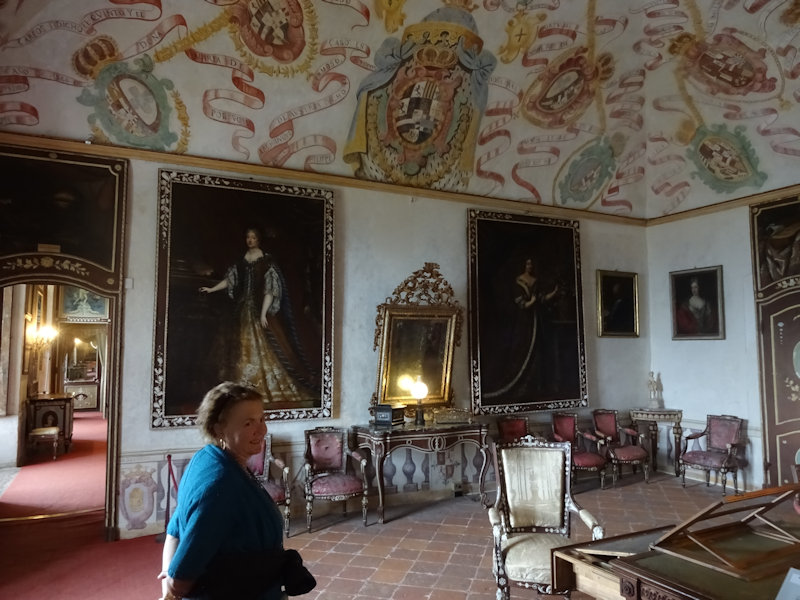
Back to the ground floor, this is the bedroom part of the "Viceroy's Apartment" so-called, with 19th century decor.
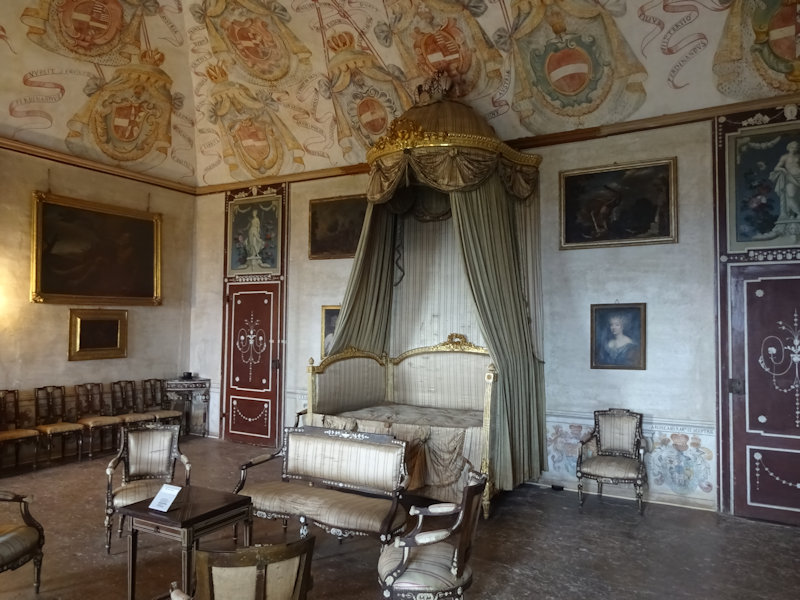
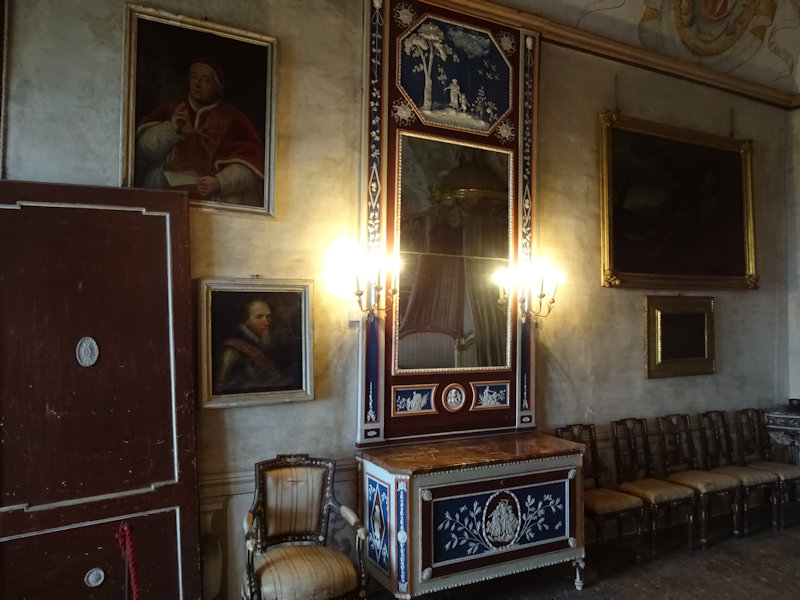
The decorative white trimmings are evidently made of rice, but our guide tells us that nobody knows how.

Our guide in his element
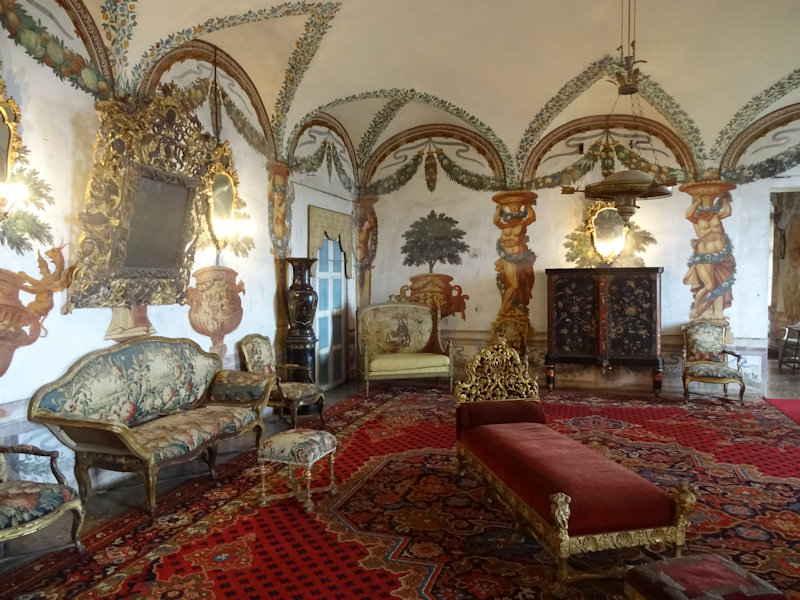
Passing through the Gobelins Room, with 17th century frescoes

The Round Salon, evidently a kind of smallish ballroom with benches fixed to the walls, on the ground floor of the old tower . . .
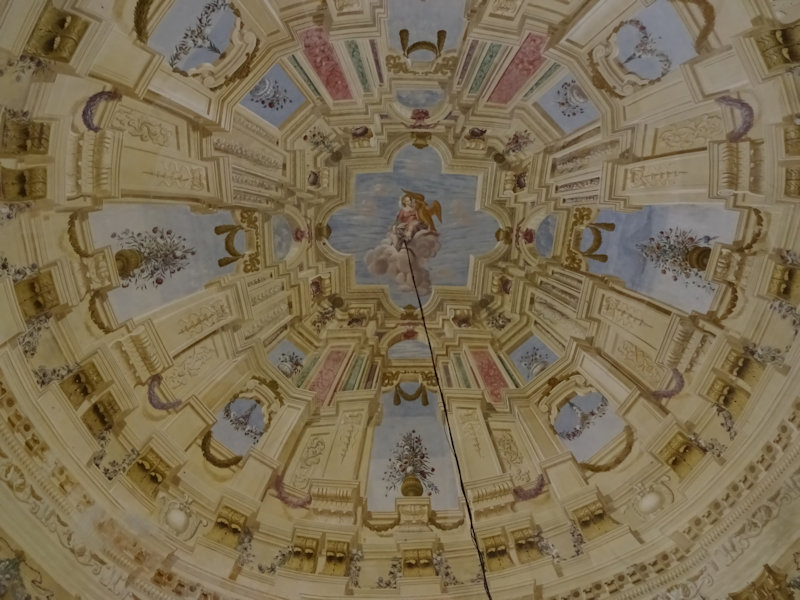
. . . with its trompe l'oeil cupola.
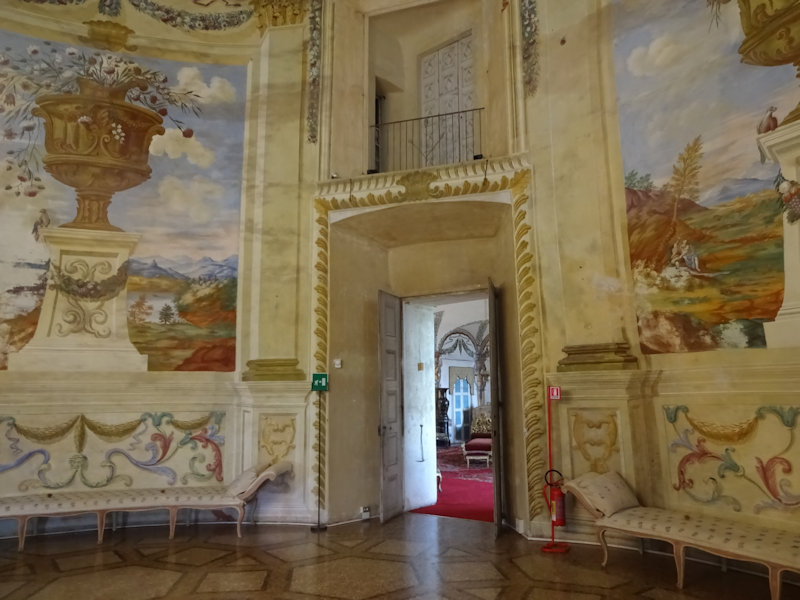
It's thought that the landscapes seen through the fake windows were done by the Galliari brothers, famous 18th century scene painters from the Teatro Regio in Turin.

The Billiard Room, with 17th century frescoes of sea battles, caryatids, and slaves
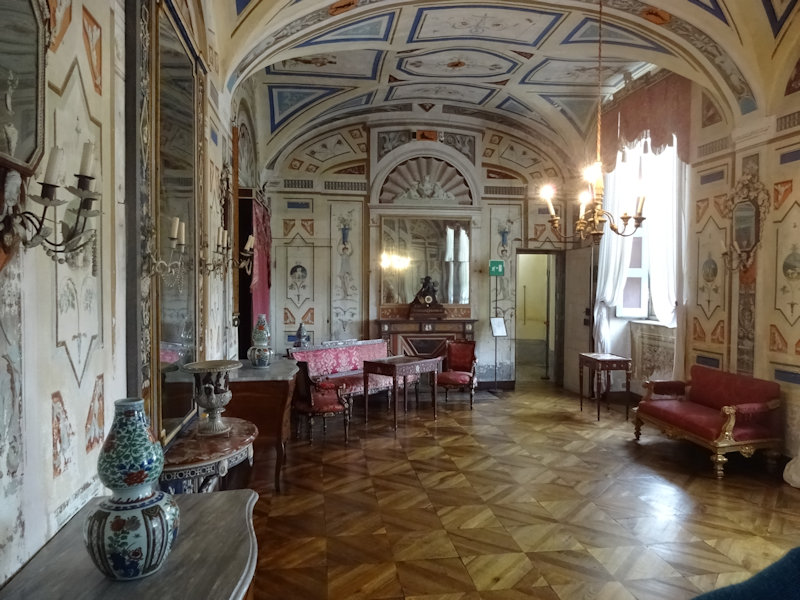
The Valperga family, Counts variously of Canavese and of Masino over time, presumably took their name from the small Canavese commune about 30km west of the Castello di Masino and 35km north of Turin. It appears that quite a few of the surviving castles of the Canavese historical region of the Piemonte were in Valperga hands at one time or another.
Mary Shelley's novel Valperga (1823), based loosely on the life of Castruccio Castracani of Lucca, is unrelated; her father chose the title, after the fictional Tuscan castle in the story.
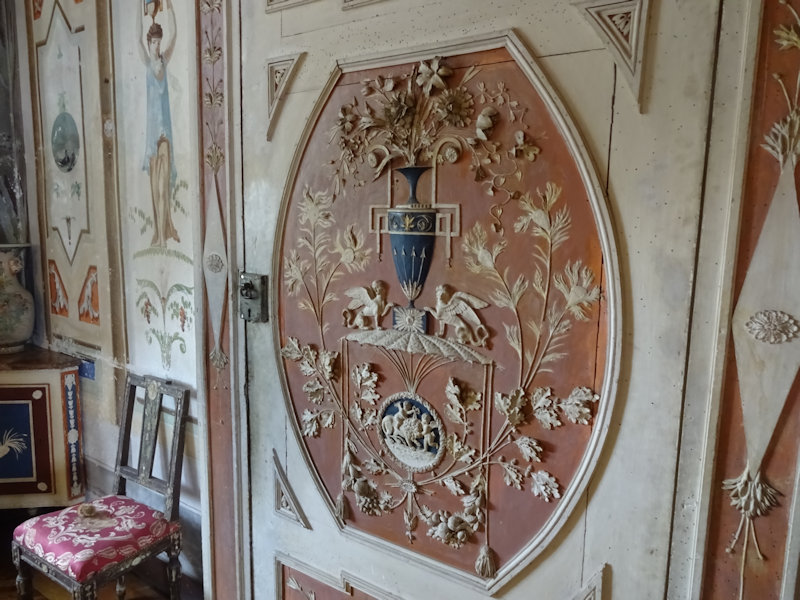
Rice
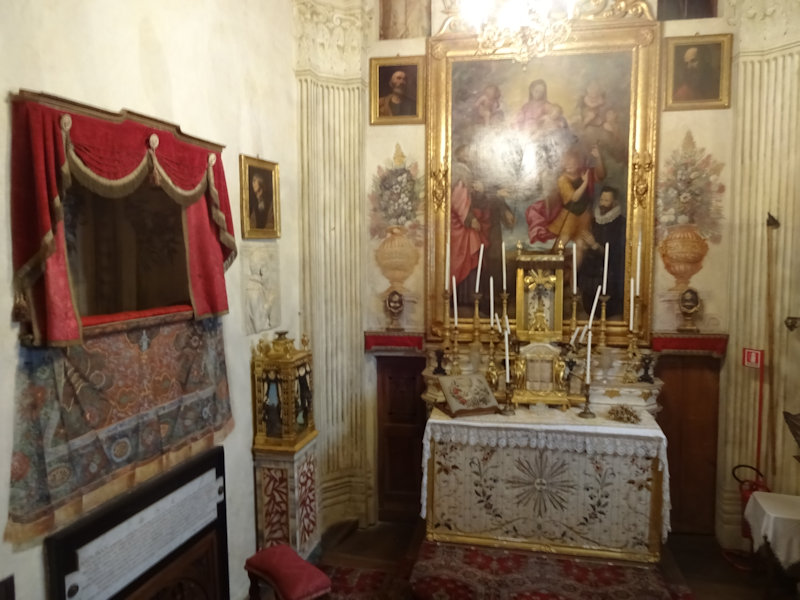
The tiny San Carlo Chapel, dating from at least 1631, named for Cardinal Saint Charles Borromeo, the famous anti-Protestant church reformer and Archbishop of Milan, who stayed here in 1578. The urn on the left is said to contain the ashes of King Arduino himself, transferred here in the 18th century.
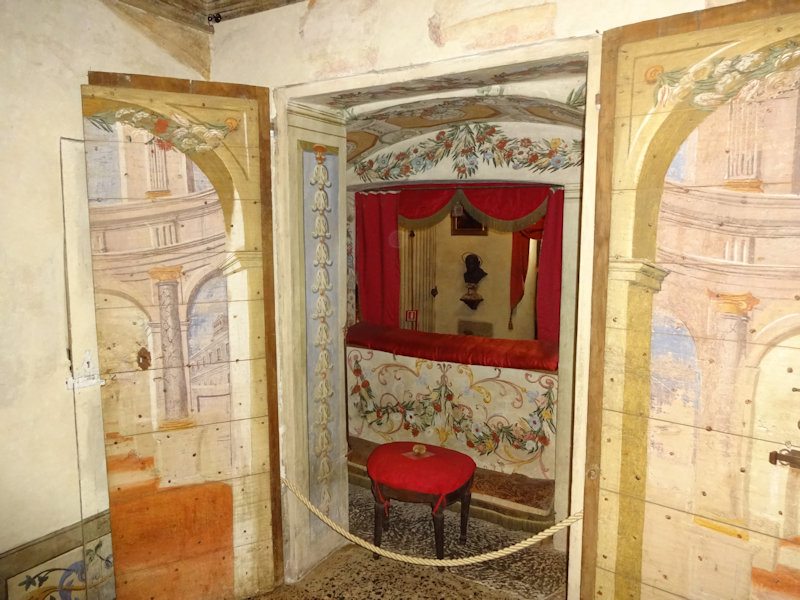
Out in the corridor, a private closet for viewing the goings on down in the San Carlo chapel
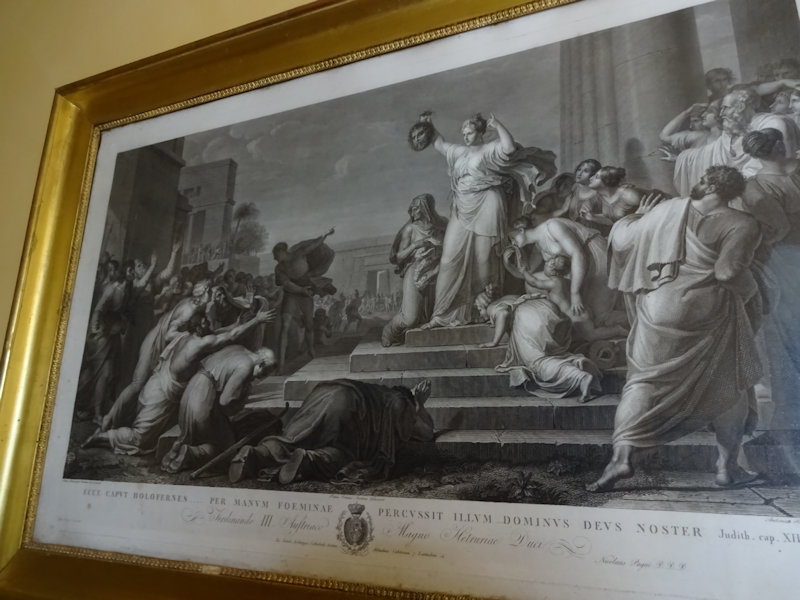
An innovative take on the Judith and Holofernes story -- it's got the aged nurse and all, but no cathartic moment of passionate hacking.
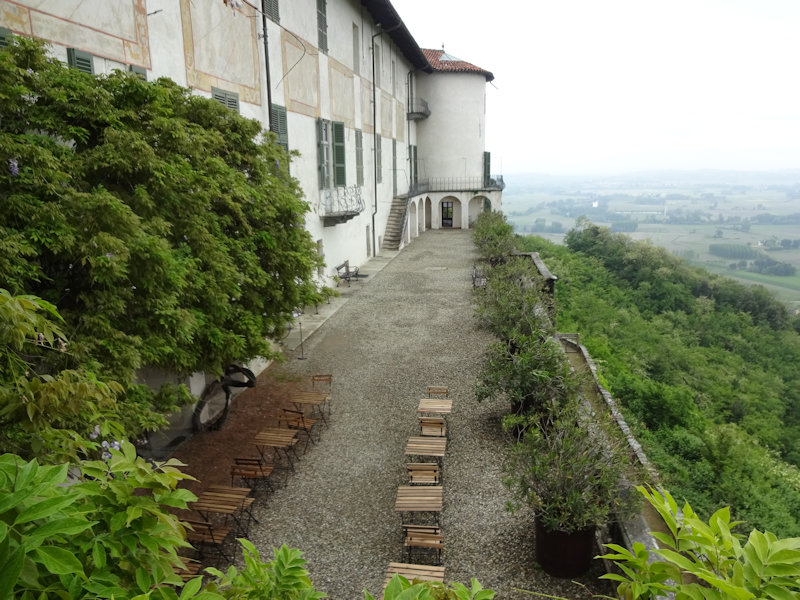
The Oleander Terrace, facing out to the west
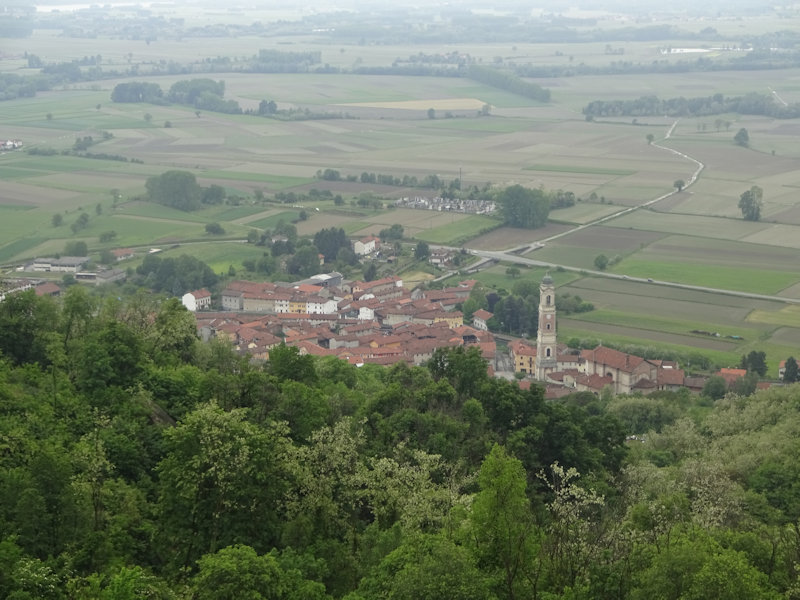
The comune of Borgomasino below to the southwest, along the Naviglio di Ivrea or Ivrea canal.

The English garden running westward out along the moraine/hill
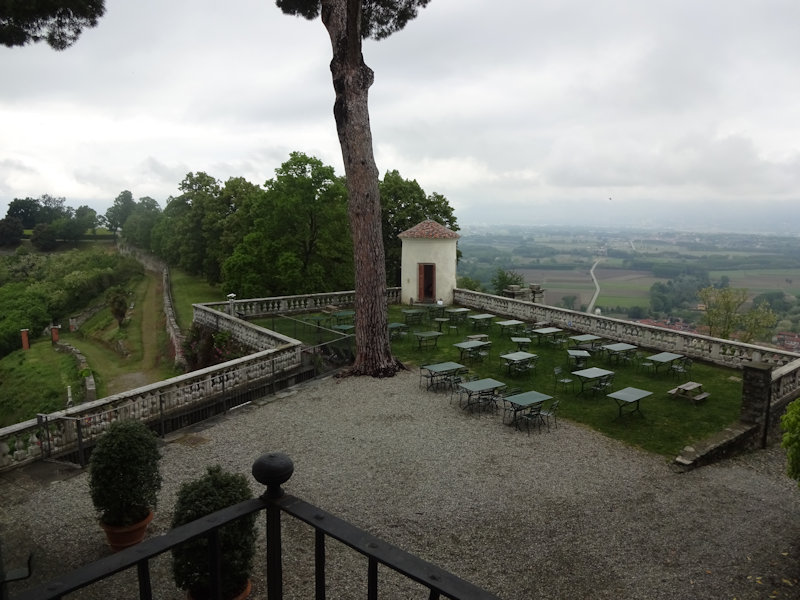
The cafeteria terrace

The Torre dei Venti, or Tower of the Winds (seen above), on the present ground floor level of the castle

The Castello di Masino from the Tower of the Winds, with the ancient original walls below
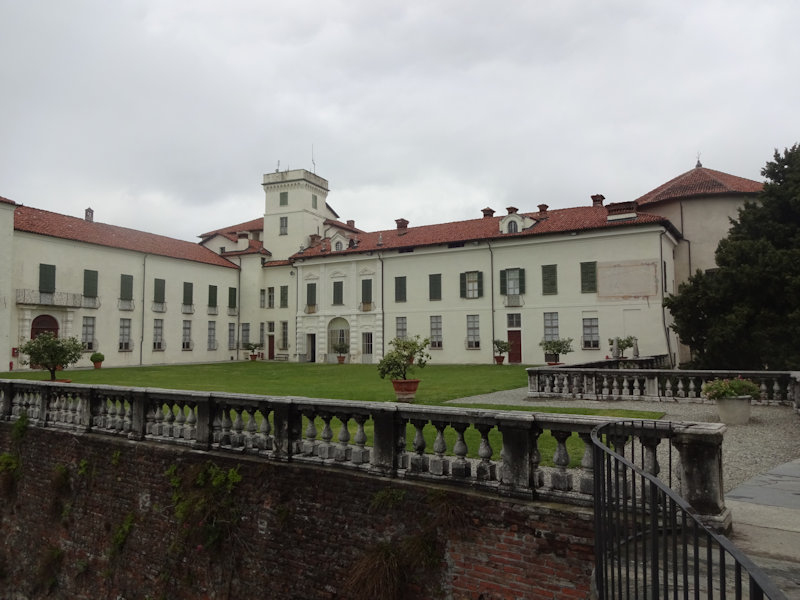

The borgo of the castle descending eastward below the Tower of the Winds
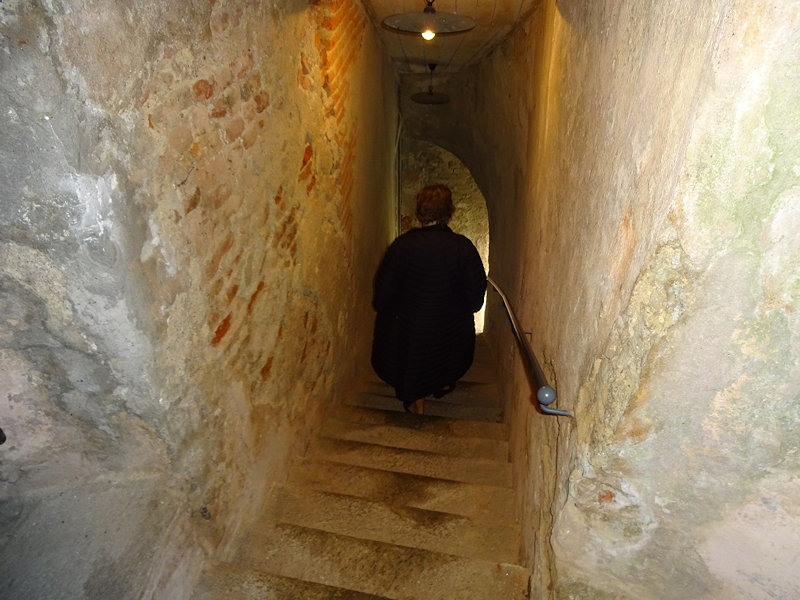
Down through the Torre dei Venti
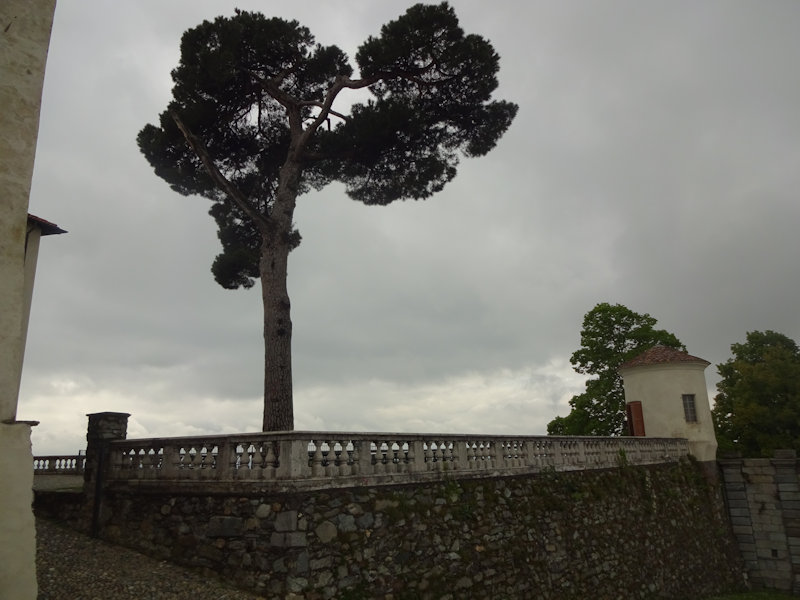
The cafeteria terrace
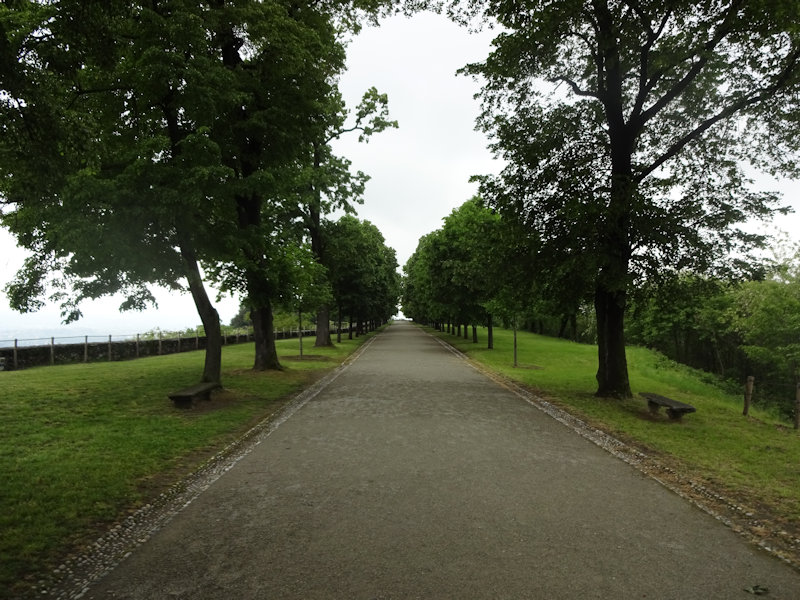
The walk westward through the gardens, towards the labyrinth
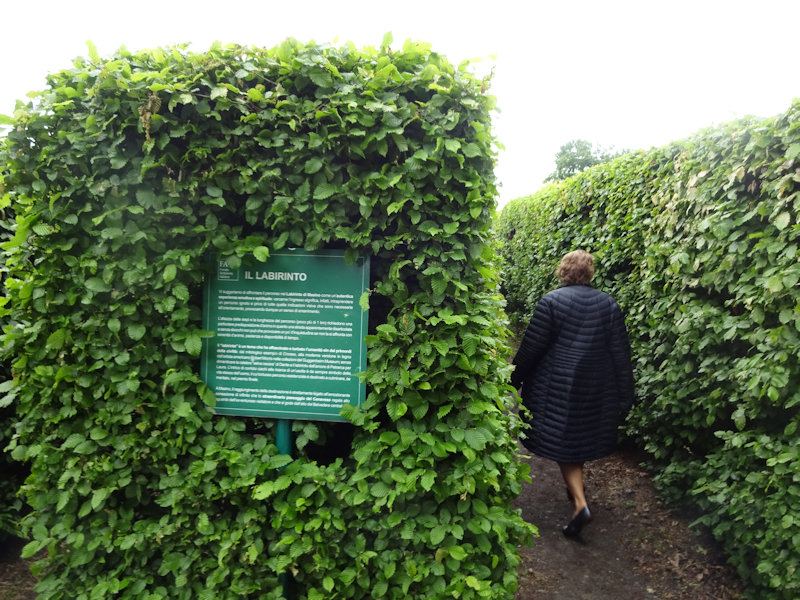
-- No wait! Don't . . .
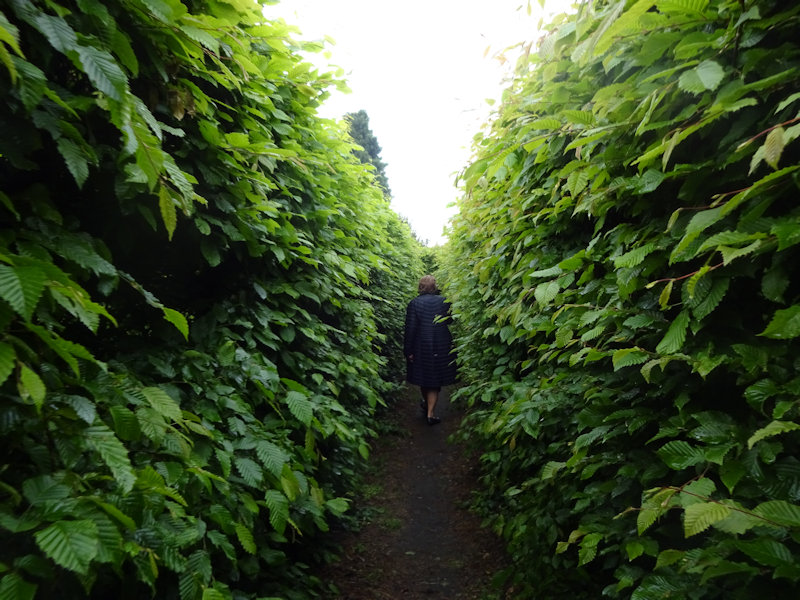
Three quarters of an hour later . . .
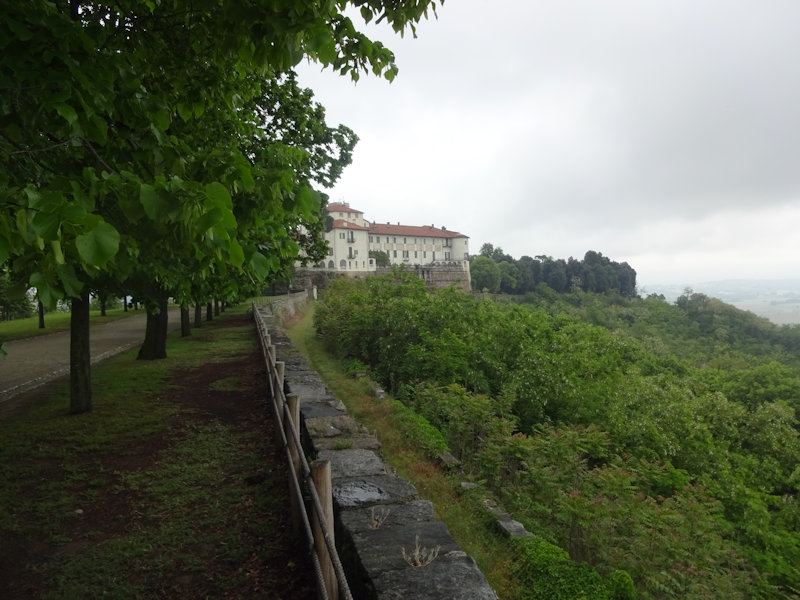
The Castello di Masino from near the labyrinth
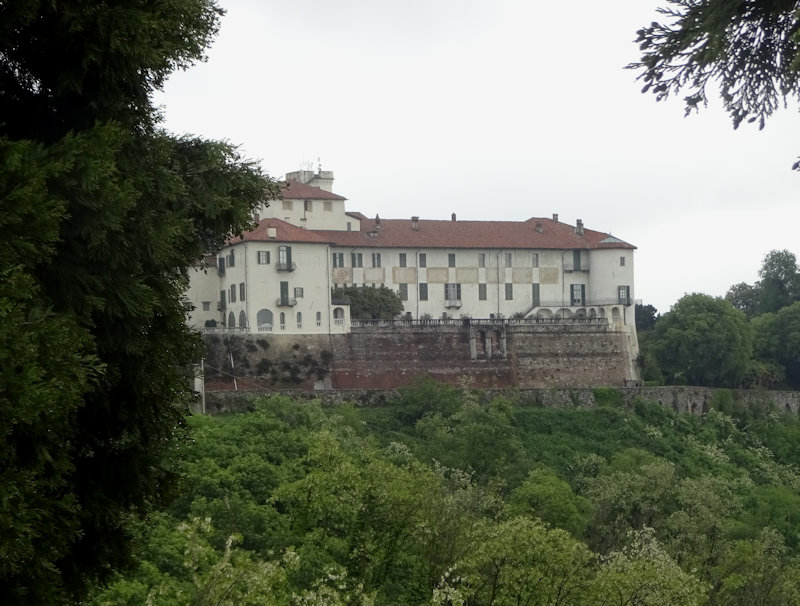
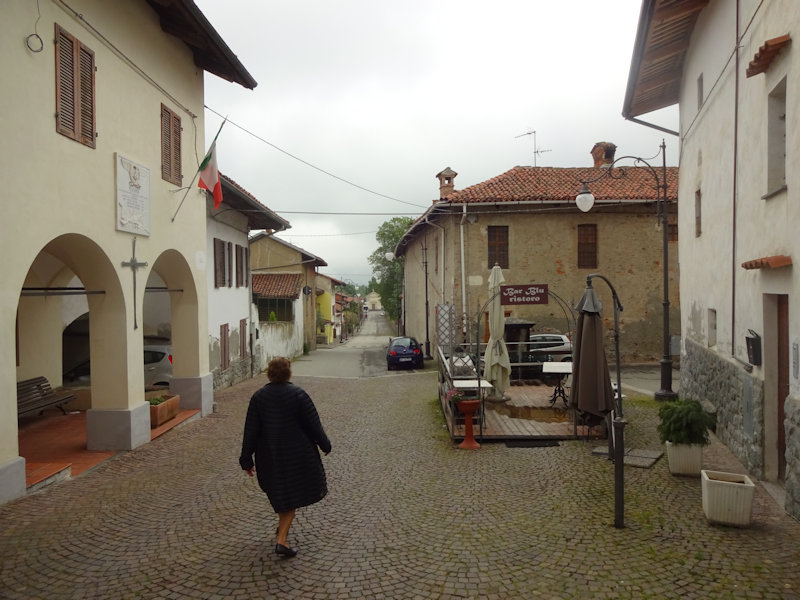
Back to the car
Sirmione on Lago di Garda
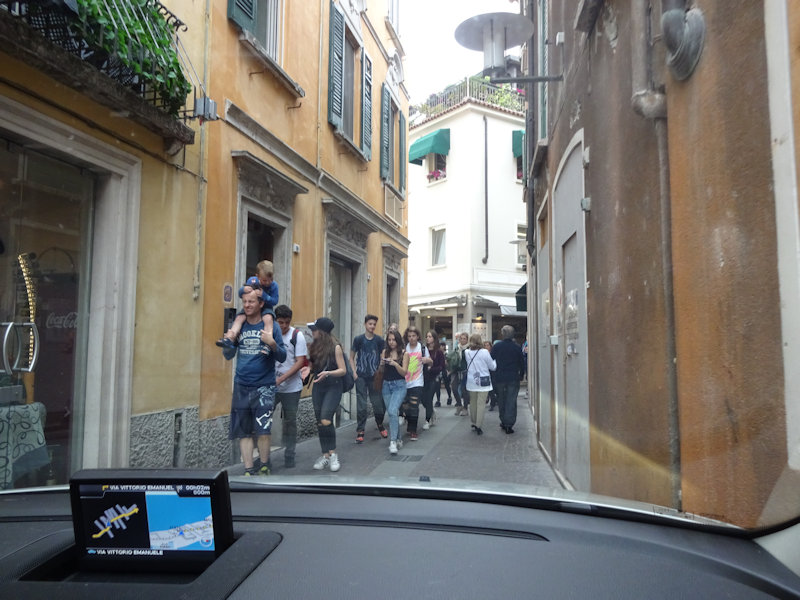
Arriving in Sirmione on Lago di Garda -- what have we got ourselves into?

Inside the city gate, the Piazza Castello

The Castello Scaligero, or Castle of the Della Scalas, begun in the late 13th century. Our hotel is meant to be at the foot of it, across the moat of course. We've got the car in this far, but may not be able to get it out again.
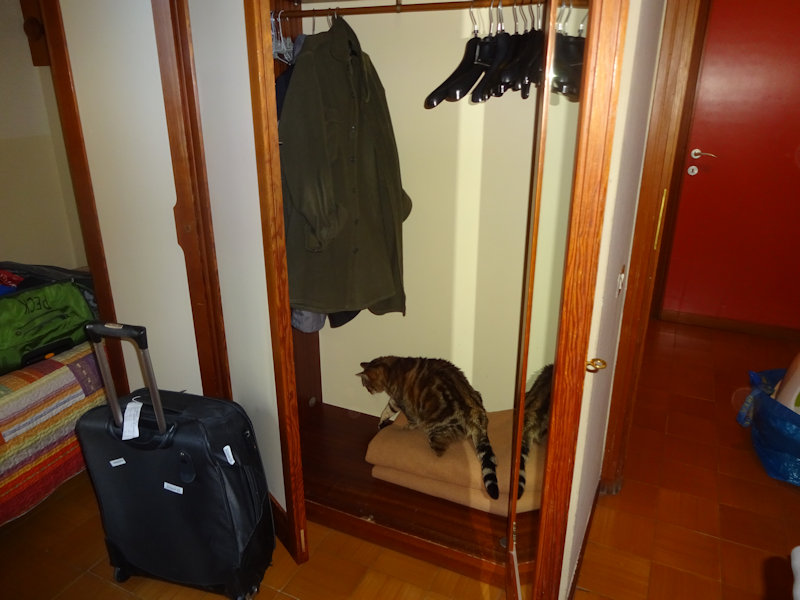
Squirrel getting settled into the nearest armoire
      
     
  

 Feedback
and suggestions are welcome if positive, resented if negative, Feedback
and suggestions are welcome if positive, resented if negative,  .
All rights reserved, all wrongs avenged. Posted 13 July 2016. .
All rights reserved, all wrongs avenged. Posted 13 July 2016.
|
 Dwight Peck's personal website
Dwight Peck's personal website































































